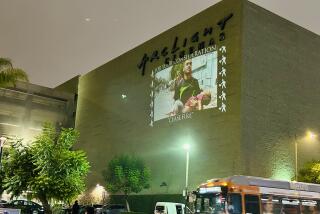Museum Pulls Painting After Picket Threat by Vietnamese
- Share via
SANTA ANA — Bowers Museum officials have removed one painting from a planned exhibit of Vietnamese art and may pull others after anti-Communist activists threatened to picket the show when it opens Saturday.
Mindful of massive demonstrations organized by Vietnamese activists earlier this year to protest a Communist flag in an Orange County video store, officials at the Santa Ana museum say they are trying to balance community concerns with the 1st Amendment.
“We’re not allowing [the Vietnamese community] to dictate what we display. We were giving them an opportunity to voice their views so that we could make an informed decision,” said Janet Baker, curator for Asian art and director of public programs at Bowers.
But 1st Amendment advocates and museum experts say Bowers Museum officials are wrong for letting political pressure influence which paintings they hang.
“I think it’s incredible that the Bowers Museum would even consider yanking a piece because somebody disagrees with it,” said Ron Talmo, a Santa Ana attorney.
Talmo said removing works would hurt the exhibit in the end.
“The more art pieces, the more variety, the more different views we have, the better off we’ll be,” said Talmo. “That’s a principle of the way we live in this country.”
He has clashed with Vietnamese activists before, having served as a lawyer for Truong Van Tran, the video store owner who sparked weeks of protests in Westminster earlier this year by displaying a Communist flag.
The same activists who protested against the flag say the Bowers show of contemporary paintings from Vietnam, a traveling exhibition displayed at museums across the country in the last 18 months, has the feel of Communist propaganda. The group plans to have protesters at the museum until the show ends Sept. 30.
The Vietnamese activists are largely immigrants who, along with their families, suffered under Communist rule.
Although they acknowledge that the art does not explicitly support communism, activists say the exhibition--assembled by a panel of artists in Vietnam and the United States--allows the Vietnamese government to present a false impression to Americans.
“We only want Americans to understand that we fear the Vietnamese government is trying to manipulate things,” said Tuan Anh Ho, head of the Committee for Just Cause of Free Vietnam.
“The art itself is not the problem,” said Westminster attorney Van Thai Tran. “It’s the intent here. The whole idea of passing over the American community that Vietnam is a country that is flourishing in free expression of art and culture is a big lie. That’s Hanoi trying to do a soft sell.”
After weeks of meetings with activists, museum officials said this week they will withhold at least one painting, “Young Woman Forging Steel,” because the tempera-on-canvas work depicts a young girl dressed in the uniform of a North Vietnamese soldier.
The museum also is considering taking out others from the collection of 75 pieces, including one titled “Love,” which depicts a woman with a red water buffalo. Another work under pressure to be removed is called “Mother’s Heart,” which shows pictures of young soldiers in the background as a woman prays before an altar.
Critics say the paintings advocate the Communist cause.
Bowers officials say they are not compromising their artistic standards, though they acknowledge that protesters played a role in their decision. Vietnamese community members were given a preview of the show two weeks ago.
“We sensed we could move into an area where a large number of people might be quite hurt,” Baker said.
“If you had a showing of German art, would you put something with Nazi symbols in it? These are sensitive issues where there is no right or wrong answer,” she said.
The controversy spotlights the rights of museums to display provocative art with their responsibility to local sensitivities, say museum experts.
“Museums are in danger of being criticized in either direction, regardless of what they do,” said Teri Knoll, executive director of the California Assn. of Museums.
In this case, the Bowers decision is appropriate, given that museums are “first and foremost there for the community they serve,” she said.
Others argue that museums should not censor art because of public pressure.
“It’s a slippery slope. Once you begin to acquiesce to public pressure, then where do you stop?” said professor Mike McGee, head of the exhibition design and museum studies program at Cal State Fullerton.
Museums can preserve artistic integrity while responding to a community’s concerns, McGee said, by setting aside exhibit space for alternative works or creating a forum for the public to speak out.
The Contemporary Arts Center in Cincinnati, for example, answered outrage over sexually explicit photographs by Robert Mapplethorpe in 1990 by showcasing the objectionable works separately, with warnings to viewers.
Not everyone in the Vietnamese American community believes the exhibit should be boycotted.
“I’m as anti-Communist as anyone, but people have to realize you can’t undo the past,” said Quang X. Pham, a businessman and former U.S. Marine Corps pilot who was invited to the preview. “I think everyone should come see and judge for themselves. Otherwise, it’s censorship.”
The exhibition, titled “A Winding River,” was put together by Meridian International Center, a Washington, D.C.-based nonprofit international relations group that attempts to foster understanding among countries.
The drawings and paintings, chosen by an independent panel of American and Vietnamese art experts, date from the 1940s to the present, with most from the last five years, said Curtis Sandburg, the group’s director of exhibitions.
“We’re well aware there’s a lot of pain and suffering from the Vietnam War experience and we’re sympathetic. But we’re hoping the show becomes a point of discussion for the whole community,” he said.
More to Read
The biggest entertainment stories
Get our big stories about Hollywood, film, television, music, arts, culture and more right in your inbox as soon as they publish.
You may occasionally receive promotional content from the Los Angeles Times.










